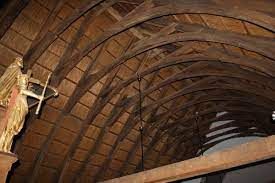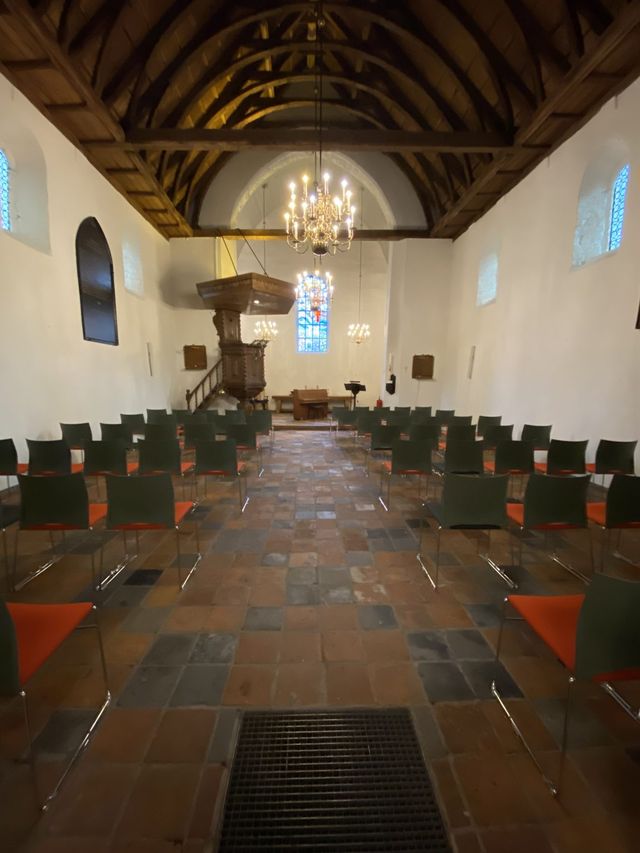Het Boterkerkje - the oldest church in the region
Contact
Vrijthof 3
5688 AE Oirschot Plan your route to Het Boterkerkje - the oldest church in the region

The Boterkerkje is one of the oldest church buildings in the region. It dates from 1125. Although the church is of unprecedented beauty from the outside, when you enter this building the centuries descend on you. The beautiful gable roof, the walls with their modest windows, the unique organ: the visitor enters an enchanting, authentic world that invites to inspiring activities.
The Boterkerkje - the oldest monument in Oirschot - is a building full of character. Sober and modest, but also solid and strong, it has stood on the Vrijthof for about nine centuries, from the beginning of the twelfth century. The walls are made of tuff stone, originally from the Eifel. However, this probably involves the reuse of stones from a dilapidated Roman building in the area.
Romanesque church
The church st…
The Boterkerkje is one of the oldest church buildings in the region. It dates from 1125. Although the church is of unprecedented beauty from the outside, when you enter this building the centuries descend on you. The beautiful gable roof, the walls with their modest windows, the unique organ: the visitor enters an enchanting, authentic world that invites to inspiring activities.
The Boterkerkje - the oldest monument in Oirschot - is a building full of character. Sober and modest, but also solid and strong, it has stood on the Vrijthof for about nine centuries, from the beginning of the twelfth century. The walls are made of tuff stone, originally from the Eifel. However, this probably involves the reuse of stones from a dilapidated Roman building in the area.
Romanesque church
The church started as a Roman Catholic church and was dedicated to Mary. It is a textbook example of the Romanesque architectural style. In the west facade this is most recognizable in four savings fields, rounded at the top with four round arches. In this early period there was a choir section measuring six by nine meters on the east facade. This choir served all members of the Chapter. They sat in a semicircle on benches against the outer walls. This Romanesque choir was later replaced by a Gothic choir with more pointed shapes, pointed arches, higher windows that was higher than the nave of the church. At the same time as the Gothic choir, the church will receive a new wooden roof construction, which is now fully visible. More than half of the oak trees still date from that period.
On the second plan
The church - also called Our Lady's Church - became a second priority around 1268. During that period, a new, much larger church was built on the market square: St. Peter's Church. Normally a Gothic church was built on top of its Romanesque predecessor, but on the Vrijthof there was not enough room to do this; it would prove to be the salvation of the Boterkerkje.
The building on the Vrijthof apparently remained in use and was referred to as a 'chapel' from then on. After a major village fire in 1623, the market moved to the new church and the Vrijtof was rebuilt with new buildings, including restaurant De Zwaan.
Buttermarket
When Protestants gain control in Brabant, this will also have consequences for the use of the church buildings in Oirschot. The Protestants - however small in number - use the large St. Peter's Church. Roman Catholics are not even allowed to use the small church on the Vrijthof.
In 1648, a permit was applied for for use as a butter weighing house: on market days the butter remains nice and cool between the thick walls. Hence the 'nickname' Boterkerkje.
Reformed church
In 1799 the decision was made that the large St. Peter's Church should return to the Roman Catholic community. The small church is assigned to the 'protestand or reformed community'. They put the church into use in 1800 after restoration work. In 1804 they purchased the current pipe organ (built in 1751 by the Middelburg organ builder Ludovicus de Backer). In 1880 the large Gothic choir was demolished due to dilapidation.
Restoration
A major restoration took place in 1960/1961 in which the original Romanesque character was restored as much as possible.
Nowadays the church is only occasionally used for church services by the Protestant community. As of 2020, it is no longer an official house of worship, although services are still held there on a regular basis. But the church is now mainly used for exhibitions, concerts, lectures and workshops, in addition to weddings and funerals.






